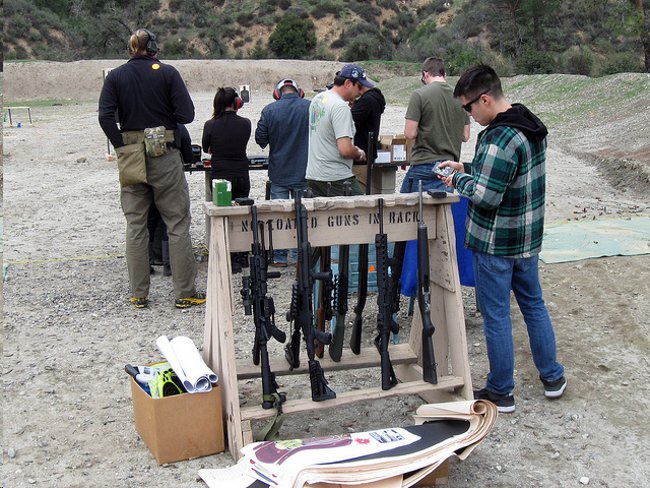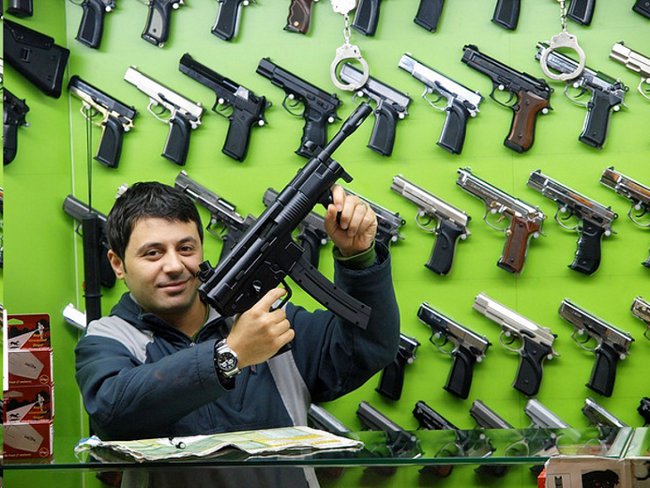America’s Hazardous Gun Culture

Americans, especially men, are renowned for their affinity with guns.
“I grew up with love for the outdoors… shooting sports…and the second amendment,” said Jacob Herman in the documentary series Gun Culture in America.
Herman, the chief operating officer of Red Jacket Firearms, a gun manufacturer based in Louisiana, describes how guns are as much a part of him as his last name. In short, for Herman, the gun industry is more than just his bread and butter, it’s his vocation.
“My granddad had an outdoor bait-and-tackle shop growing up. I was [born] a week early and they hadn’t put the crib together yet…my mom had me in a box behind the counter that they had made into a crib on opening day of gun [deer hunting] season,” said Herman in the documentary as he recounted a childhood story, which exuded his passion for firearms and hunting.
Herman’s personal anecdote, however, is only a link in a chain of stories and experiences that spans across generations of gun owners. The US gun stock: results from the 2004 national firearms survey, published on the National Center for biotechnology website, confirms this.
The results of this telephone survey stated that men reported firearm ownership more frequently than women. Moreover, it supported previous reports of gun ownership demographics illustrating that firearms are most likely to be owned by white middle-aged, middle-class men.
The study also shone light on another commonality shared by this demographic— location. These middle-aged white men were also predominantly from the Southern or Midwestern rural regions of the country, and grew up with guns in the home. Furthermore, it validated Herman’s passion for hunting since it mentions that the most prevalent type of gun in the U.S., according to their survey, was the long gun, i.e., a rifle or shot gun.
Love for the Second Amendment
Herman’s reference to the second amendment was prideful -- infused with patriotism for the country that affords him the right to keep and bear arms. Ironically, this undeniable right that seems so embedded in American history actually has its roots in English common law.
“That the subjects which are Protestants may have arms for their defence suitable to their conditions and as allowed by law,” reads the English Bill of Rights of 1689, according to the text published in 2008 on the Lillian Goldman Law Library database at Yale Law School (The Avalon Project: documents in law, history and diplomacy ).
Although the historical link between the English Bill of Rights and our own is evident, it doesn’t bring clarity to the question of why America is a gun culture, and if the reason for which the second amendment was originally intended— self-defense and to fight against oppression – are applicable today.
Carole Emberton, a history professor at the University of Buffalo, offers one response to America’s seemingly insatiable appetite for firearms in her History News Network article, The Real Origin of America’s Gun Culture.
“Although the production of personal firearms began to rise in the 1830s, there is little doubt that the Civil War led to an unprecedented proliferation in weaponry,” writes Emberton. This unifying theme leads into the explanation of the birth of the gun industry and the popularization of personal firearms.

In her article, Emberton relates a sequence of historic events that illustrates how the post-Civil War reconstruction era called for a need to keep and bear arms, rather than a right. After freed slaves earned the right to vote, they also found it imperative to protect that right from white supremacist militias who wanted to intimidate and keep them from the ballot box.
By this time Samuel Colt and his invention, the revolver, was being mass-produced along with other firearms and made available at local stores.
Meanwhile, aided by propaganda and radical Republicans, the word spread that in order to protect freed blacks they had to “reaffirm both voting and private gun possession as twin rights of post-emancipation citizenship.”
As a consequence, notes Emberton, these paramilitary supremacists executed armed assaults on local and state offices headed by Republicans claiming that it was a fight against tyranny.
“The proliferation of firearms coupled with the emancipation of Southern slaves gave rise to a new tenet within American political culture that tied freedom and citizenship to guns,” writes Emberton in her concluding remarks. Put differently, these events oriented a young America towards a nation that has record-high civilian firearm sales per capita in the world.
Americans, incorrigibly violent
“There is no correlation between gun ownership and gun violence,” states Adam Winkler, author of Gunfight: The Battle Over the Right to Bear Arms in America. Although he does concede that countries that have put in place strict guns laws, or completely eliminated firearm possession, like Japan, will undoubtedly have little to no gun violence.

Currently, the U.S. ranks number-one in countries with the highest rate of civilian gun ownership per capita, according to the Estimating Civilian Owned Firearms report published by Small Arms Survey in September 2011. Using a scale of comparison, Americans own more guns than Israelis or Iraqis living in the embattled Middle East.
Furthermore, a 2013 Small Arms Survey report stated that between 1986 and 2010, gun manufacturers have produced more than 98 million pistols, revolvers, rifles and shotguns for domestic sale.
But to eradicate all guns from civilian possession, implies challenging the gun industry accompanied by its powerful lobby, and changing the minds of millions of pro-firearm activists. The most viable option and the one that seems to have a stronger correlation with gun violence is stricter gun laws.
Winkler, a law professor at UCLA who specializes in constitutional law, says he is in favor of stricter gun laws, but adds that “you can reduce gun violence, but you can’t eliminate it.” He cites the Obama administration’s efforts to expand background checks as a step in the right direction, but dissents to some of his other proposals.
Many cities are also resorting to implementing buyback programs as part of an initiative to reduce street shootings. The New York Police Department, for example, has been employing these types of programs for some time, according to Simone Weichselbaum of the New York Daily News, who reports that “the NYPD has collected more than 8,000 guns since 2008.
Winkler is skeptical, however, saying that the majority of the people who hand in firearms are not the same people who are committing the crimes on the streets.
When looked at from the sidelines, the issue seems like a never-ending tug of war. Which team will prevail? Whenever there’s a senseless massacre that angers the nation, it seems that more spectators are coming down from the stands and joining the side pulling to end gun violence, but the other side seems to rarely budge.
Author Bio:
Yolian Cerquera is a contributing writer at Highbrow Magazine.
Photos: Toasty Ken; Simonov; Paljoa Kim (Creative Commons).






























































































































































































































































































































